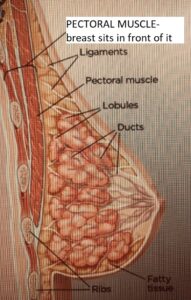I was told by a bunch of teenage girls the other day that “You just need to do exercises to keep your breasts perky.”
What the what?!? Where did this come from? I’m sure the answer is TikTok or Snapchat, but even that information has to start somewhere. So I googled it. There were titles, “10 exercises to lift, firm, and perk up your breasts,” “4 exercises to lift your boobs,” “13 breast firming exercises.” I found a lot of stuff about bench presses, planks, and handweights. Mind you, none of these articles were from medical journals. If any of this were true, 1. I would be doing it myself, and 2. I would be out of a major portion of my job (which is to lift breasts).
I am a plastic surgeon who specializes in breast surgery. I do tons of breast lifts, breast reductions, and breast augmentations each year. I see big breasts and small breasts, dense breast tissue breasts and super fatty breasts, saggy breasts and perky breasts. You get the idea. I see a lot of breasts. Do not confuse breast tissue- which is made up of breast tissue, fat, ligaments, and breast ducts- with muscle. When I am doing breast surgery, the pectoral muscle is totally 100% behind your breast tissue. There is a loose connection between the breast and the muscle by ligamentous fibers, but toning up your pectoral muscles does not lift your breasts. Period. And there is no way to tighten the ligaments or tighten the skin.

Breasts droop because of
- gravity
- poor skin tone
- stretched out skin
- stretched out ligamentous connections
- weight of breast tissue
- poor support
When you have aging, menopause, breast feeding, pregnancy, and weight changes your skin tone worsens. When you have large breasts, they weigh a lot, and gravity pulls the weight down. When you wear poor support, the only thing holding up that weight is your skin—but skin stretches.
So why are people different?
- Dense breast tissue. Those with more breast tissue (as opposed to fat) likely have more ligamentous connections, which help keep the tissue lifted.
- Skin tone. Those with better skin tone age better. (Think of skin as being like a bathing suit — some get a Speedo, versus a those who get a less well made, no name brand which is a couple of years old and lost its elastic)
- Smaller breast size. The smaller the breast, the less it weighs.
- You haven’t stressed the breast out. That means no pregnancy, no breast feeding, no major weight changes, no jogging.
So my recommendation?
SUPPORT SUPPORT SUPPORT. This means buy good bras (read my blogs on bras HERE). Wear support at night time. Wear tons of support when jogging. Once your skin and ligaments are stretched out, there is no nonsurgical way to unstretch them.
Prevention is the key.
The information provided on this website is for general informational purposes only and does not constitute medical advice, diagnosis, or treatment. Always seek the advice of a qualified healthcare provider for any questions regarding your health or medical condition.
